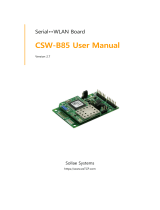4 Operation Modes ................................................................................................................ - 27 -
4.1 What is the Operation Mode? .................................................................................................................. - 27 -
4.2 How to entering each mode ..................................................................................................................... - 27 -
4.3 Comparison with each mode .................................................................................................................... - 28 -
4.4 Normal Mode ................................................................................................................................................... - 28 -
4.5 Serial Configuration Mode ......................................................................................................................... - 29 -
4.5.1
Configuring arameters ........................................................................................................................ - 29 -
4.5.2
Revoking Serurity Options................................................................................................................. - 29 -
4.6 ISP Mode ............................................................................................................................................................ - 29 -
4.6.1
Upgrading Firmware............................................................................................................................. - 29 -
5 Communication Modes ...................................................................................................... - 30 -
5.1 TCP Server .......................................................................................................................................................... - 30 -
5.1.1
Key parameters ....................................................................................................................................... - 30 -
5.1.2
Examples .................................................................................................................................................... - 31 -
5.2 TCP Client ........................................................................................................................................................... - 34 -
5.2.1
Key parameters ....................................................................................................................................... - 34 -
5.2.2
Examples .................................................................................................................................................... - 35 -
5.3 AT Command .................................................................................................................................................... - 37 -
5.3.1
Key parameters ....................................................................................................................................... - 37 -
5.3.2
Examples .................................................................................................................................................... - 38 -
5.4 UDP ....................................................................................................................................................................... - 41 -
5.4.1
Key parameters ....................................................................................................................................... - 41 -
5.4.2
Examples .................................................................................................................................................... - 42 -
6 System Management .......................................................................................................... - 44 -
6.1 Upgrading Firmware ...................................................................................................................................... - 44 -
6.1.1
Firmware .................................................................................................................................................... - 44 -
6.1.2
Processes ................................................................................................................................................... - 44 -
6.2 Status Monitoring ........................................................................................................................................... - 46 -
6.2.1
Using TELNET .......................................................................................................................................... - 46 -
6.2.2
Using ezManager ................................................................................................................................... - 48 -
6.2.3
Debugging Message ............................................................................................................................ - 50 -
7 Additional Functions ........................................................................................................... - 52 -
7.1 Security ................................................................................................................................................................ - 52 -
7.1.1
Access Restriction (ezTCP Firewall) ................................................................................................ - 52 -
7.1.2
Setting Password .................................................................................................................................... - 52 -
7.1.3
Using WEP ................................................................................................................................................ - 53 -





























